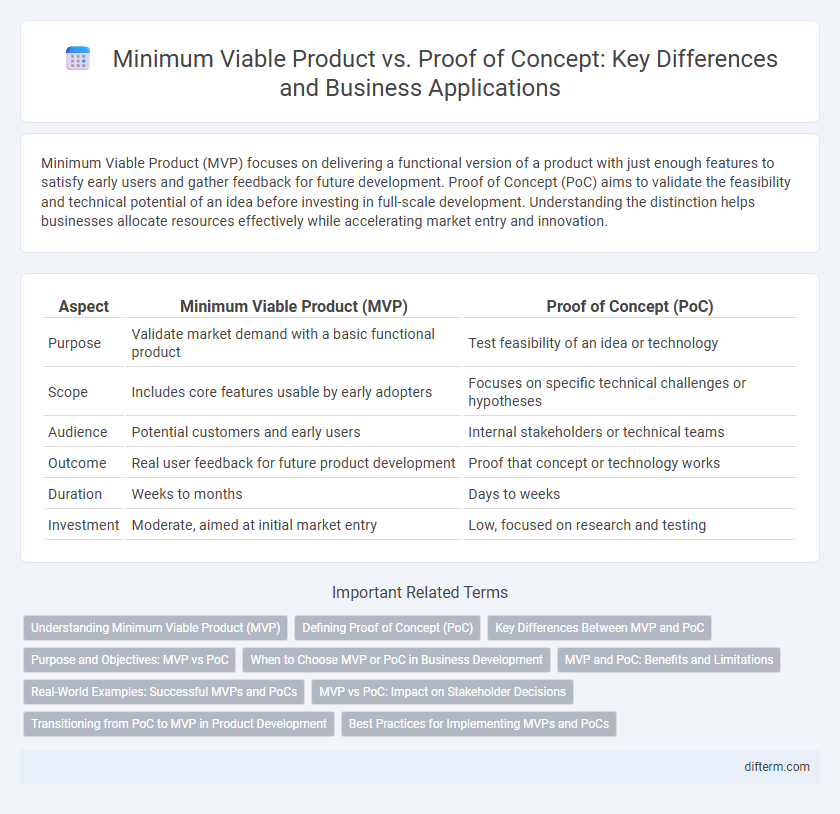Minimum Viable Product (MVP) focuses on delivering a functional version of a product with just enough features to satisfy early users and gather feedback for future development. Proof of Concept (PoC) aims to validate the feasibility and technical potential of an idea before investing in full-scale development. Understanding the distinction helps businesses allocate resources effectively while accelerating market entry and innovation.
Table of Comparison
| Aspect | Minimum Viable Product (MVP) | Proof of Concept (PoC) |
|---|---|---|
| Purpose | Validate market demand with a basic functional product | Test feasibility of an idea or technology |
| Scope | Includes core features usable by early adopters | Focuses on specific technical challenges or hypotheses |
| Audience | Potential customers and early users | Internal stakeholders or technical teams |
| Outcome | Real user feedback for future product development | Proof that concept or technology works |
| Duration | Weeks to months | Days to weeks |
| Investment | Moderate, aimed at initial market entry | Low, focused on research and testing |
Understanding Minimum Viable Product (MVP)
A Minimum Viable Product (MVP) is a development technique in business designed to release a product with just enough features to satisfy early adopters and validate a product idea. It allows companies to gather critical market feedback while minimizing development costs and time, facilitating iterative improvements. Unlike a Proof of Concept, which tests feasibility, an MVP focuses on real user interaction to drive product evolution and ensure market fit.
Defining Proof of Concept (PoC)
Proof of Concept (PoC) is a critical phase in business innovation used to validate the feasibility of a product idea or technology before full-scale development. It focuses on testing key assumptions and demonstrating that a concept can be successfully implemented in a practical scenario. PoC helps stakeholders assess risks, gather early feedback, and make informed decisions on whether to proceed with building a Minimum Viable Product (MVP).
Key Differences Between MVP and PoC
A Minimum Viable Product (MVP) is a functional product version designed to test market demand and gather user feedback, while a Proof of Concept (PoC) evaluates the feasibility of a core idea or technology. MVPs involve real users and aim to solve actual problems, highlighting usability and market fit, whereas PoCs focus on technical validation without full features or user involvement. Key differences include scope, purpose, and outcome: MVPs validate market viability through launched products, whereas PoCs confirm technical possibility before product development begins.
Purpose and Objectives: MVP vs PoC
Minimum Viable Product (MVP) serves to test market viability by delivering core functionalities to early users, gathering valuable feedback for iterative development aimed at product-market fit. In contrast, Proof of Concept (PoC) primarily validates technical feasibility or innovative ideas, ensuring the solution is practically achievable before progressing to full-scale development. MVP focuses on user experience and business validation, while PoC emphasizes risk reduction and technical proof.
When to Choose MVP or PoC in Business Development
Choosing a Minimum Viable Product (MVP) is ideal when a business aims to validate market demand and gather user feedback through a functional product with core features. A Proof of Concept (PoC) is preferred when the primary goal is to test the feasibility of a specific technology or solution before investing in full-scale development. Businesses should opt for PoC in early-stage innovation to reduce technical risks, while MVP suits scenarios focused on customer validation and iterative improvement.
MVP and PoC: Benefits and Limitations
Minimum Viable Product (MVP) benefits include early market feedback, cost efficiency, and quicker time-to-market, enabling iterative product improvements based on user data. Proof of Concept (PoC) demonstrates technical feasibility and reduces project risks by validating key assumptions before full-scale development. MVP limitations involve potential market misalignment due to minimal features, while PoC may lack scalability insights and user experience evaluation.
Real-World Examples: Successful MVPs and PoCs
Spotify's launch as a Minimum Viable Product (MVP) demonstrated the power of releasing a basic version of a product with core functionalities, attracting early users and validating market demand. In contrast, Tesla's early electric vehicle prototypes served as Proofs of Concept (PoCs) to test technical feasibility before scaling production. These real-world examples highlight MVPs' role in user feedback-driven development and PoCs' importance in validating innovation before market entry.
MVP vs PoC: Impact on Stakeholder Decisions
Minimum Viable Product (MVP) offers tangible user feedback by delivering a functional version of the product, enabling stakeholders to make informed decisions based on real-world data and market validation. Proof of Concept (PoC) primarily tests feasibility and technical viability, providing stakeholders with assurance about the potential success of the underlying technology but limited customer insights. The distinct focus of MVP on market demand versus PoC's emphasis on technical proof significantly influences investment choices, project prioritization, and risk assessment in business strategy.
Transitioning from PoC to MVP in Product Development
Transitioning from Proof of Concept (PoC) to Minimum Viable Product (MVP) involves scaling validated hypotheses into functional, user-facing solutions. PoC demonstrates technical feasibility and core assumptions, while MVP emphasizes delivering essential features to early adopters for market feedback. Effective transition requires aligning development teams on feature prioritization, iterative testing, and leveraging validated insights to reduce risks in product-market fit.
Best Practices for Implementing MVPs and PoCs
Implementing Minimum Viable Products (MVPs) and Proofs of Concept (PoCs) requires clear goal setting and iterative testing to validate business assumptions and technical feasibility. Utilize customer feedback early to refine features in MVPs while ensuring PoCs demonstrate core functionality to stakeholders with minimal resources. Prioritizing rapid development, measurable outcomes, and cross-functional collaboration enhances the success of both MVPs and PoCs in reducing time-to-market and investment risk.
Minimum Viable Product vs Proof of Concept Infographic

 difterm.com
difterm.com